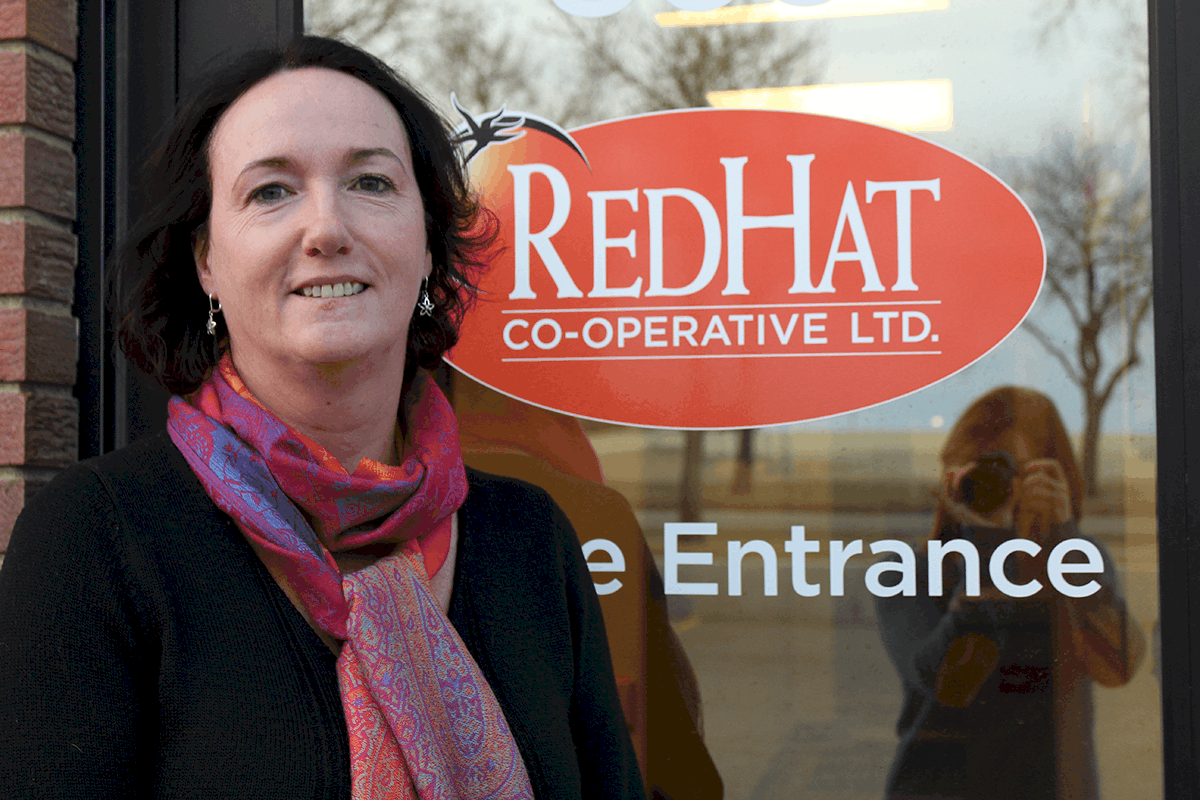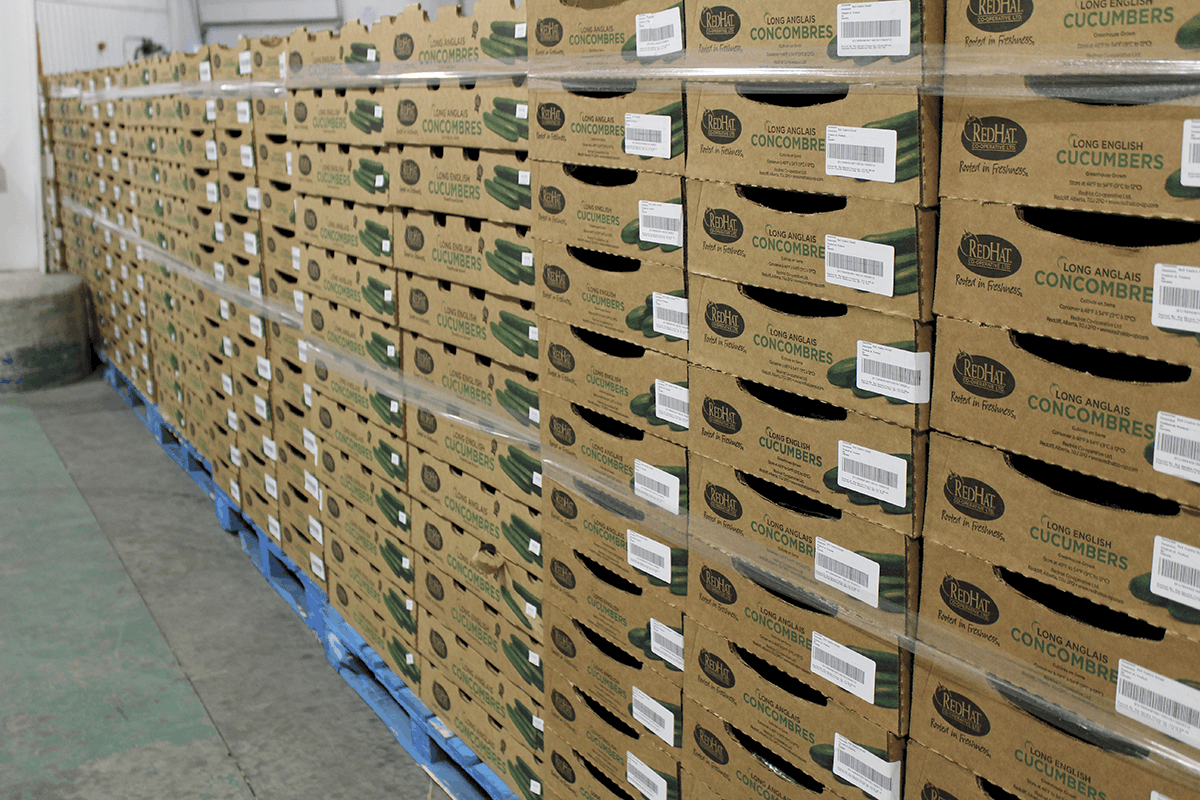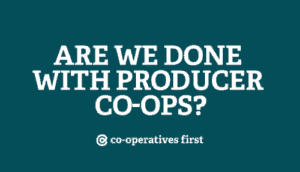For over 50 years, RedHat Co-operative has been supplying western Canada with fresh, greenhouse-grown vegetables.
The name, RedHat, stems from the co-operative’s original shareholders’ greenhouses being located near Red Cliff and Medicine Hat in southern Alberta. Considering the area’s cold winters, a thriving greenhouse industry is somewhat surprising. But it turns out, southern Alberta, thanks to the Rocky Mountains, is one of the sunniest places in Canada, making it ideal for greenhouse production.
“The climate’s good and gas is cheap,” said RedHat’s General Manager, Gillian Digman.
Growing steadily for over 50 years
Founded in 1966 by ten family-run greenhouses, RedHat Co-operative markets tomatoes, peppers, lettuce, and other fresh vegetables to major grocery chains across western Canada. Today, the packing and distribution company is a major player in western Canada’s produce market, supplying Sobey’s, Loblaw’s, Federated Co-operatives

Red Hat Co-operative General Manager, Gillian Digman outside their facility near Redcliff, AB. PHOTO: Aasa Marshall
Limited, Walmart, Costco, and Save On Foods stores, among others.
Thanks to these well-managed buyer relationships, the co-op has grown steadily. In 2012, RedHat undertook a major expansion, spending $4.5 million to double the size of its packing facility. Just last year, Red Hat formed a partnership with The Star Group distributors to supply vegetables to the United States. Likewise, the growing acreage of shareholders has increased, and the co-operative now boasts 33 shareholders – some of which run their greenhouses year-round.
Staying true to its purpose

RedHat English long cucumbers ready to be shipped out to stores across western Canada. PHOTO: Aasa Marshall
Each family-run greenhouse holds a single common share in the business, and these shareholders are RedHat’s owners. Because of this, and despite a half century of operations, changing market conditions and a lot of growth, the co-op still serves its original purpose and helps RedHat shareholders focus on what they do best: growing veggies.
“I would say that the central packing is obviously a cheaper option for everybody…just having it centrally packed, having a sales and marketing team going out there and finding the business for you, so you as a grower can focus on growing, because that’s what you do best,” Digman said. “I see it as being an ideal solution.”
An ideal solution
As we explored in a previous post, key benefits of producer co-ops is the reduction of redundancies, producer control over ownership and the creation of capacity between partnering producers. Like any successful producer co-op, RedHat is designed to increase wealth, efficiencies and capacity for its owners.
RedHat does this in multiple ways. Its packing facility allows growers to drop off their product to be sorted, packaged, and shipped to clients in massive quantities. In 2016, 5.5 million cases of produce went through the RedHat building. Each of these cases was bound for store shelves that the co-op’s marketing and sales team secure and maintain for shareholders.
Beyond logistics and marketing
To finance operations, shareholders pay a ‘pack charge’ for the services RedHat provides them. When there is a surplus, this capital is distributed back to shareholders based on how much product they provided the co-op over the year.
The co-op also reduces greenhouse purchasing costs by bulk buying inputs, like fertilizer and poly, and selling them to shareholders at cost. A credit system allows shareholders to pay for these input materials over the course of the season, helping the greenhouses better manage cash flow.
Doing what they do best
By providing these and many other benefits, the co-op allows its shareholders to focus on their core business, which is growing. Moreover, because the co-op is a business designed specifically to benefit its shareholders’ businesses, the greenhouses that have bought into RedHat benefit directly through increased sales, market share and capacity.
Each greenhouse is also able to choose how much they want to benefit from their share in the business. If they use the co-op more, they increase their sales, capacity, and purchasing power. If they choose to remain the same size, they are still able to sell their products without the headache and high cost of sorting, packing, logistics, finding buyers and maintaining relationships.
‘We must be doing something okay.’

Fresh RedHat peppers sorted and weighed for transport. PHOTO: Aasa Marshall
Digman said she feels the co-op model has proven to be flexible in dealing with growth and change, and is confident the value provided by the co-operative will continue to be an incentive for shareholders to remain both owners in, and users of, the business.
Speaking of 2017, Digman said, “We’ve had a really good year financially, the bottom line looks great, it’s the best in the history of RedHat, and last year was the best in the history of RedHat up to that point. We must be doing something okay.”




